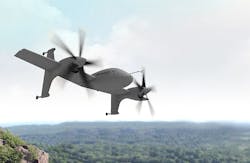DARPA competitors vying to design fast vertical-takeoff aircraft expands to four
DARPA officials announced this week they have added Karem Aircraft Inc. in Lake Forest, Calif.; and the Boeing Co. Defense, Space & Security segment in St. Louis to the DARPA Vertical Take-Off and Landing Experimental Plane (VTOL X-Plane) project.
Karem Aircraft and Boeing join Sikorsky Aircraft Corp. in Stratford, Conn., and Aurora Flight Sciences in Manassas, Va., which joined the DARPA VTOL X-Plane project last fall.
The first phase of the DARPA VTOL X-Plane program -- a four-year $130 million effort to fly an experimental aircraft that flies faster than 300 knots with a hover efficiency of 75 percent or better and a cruise lift-to-drag ratio of 10 or more.
Related: Sikorsky, Aurora Flight Sciences face off on DARPA VTOL X-Plane advanced tiltrotor project
The VTOL X-Plane program seeks to blend technologies from fixed-wing aircraft and helicopters to enable radical improvements in vertical takeoff and hover, and fast cruise flight capabilities.
During Phase 1, the four companies will conduct trade studies and develop the VTOL X-Plane's initial design. Sikorsky is teaming with the Lockheed Martin Corp. Skunk Works in Palmdale, Calif., for the VTOL X-Plane development.
Ultimately DARPA officials will downselect to one of the Phase I contractors to move forward with the second and third phases of the program, which will involve design, development, and integration, as well as flight-test demonstrations.
Karem Aircraft engineers will rely on the company's Joint Heavy Lift (JHL) and Global Reach designs for the DARPA VTOL X-Plane program. The Karem JHL design can carry M2 Bradley Fighting Vehicle and Stryker armored combat vehicles, cruise at speeds faster than 330 knots, fly at altitudes as high as 45,000 feet, and hover with military loads even with one engine out, company officials say.
Aurora Flight Sciences will rely on the company's LightningStrike VTOL X-Plane design, which is built for efficient hover and high speed. Aurora specializes in ducted-fan and hybrid-propulsion aircraft.
Boeing, meanwhile, will capitalize on the company's Phantom Swift prototype to develop an aircraft that takes off and lands vertically, hovers, and flies efficiently at speeds to 400 knots.
Phantom Swift features two large lift fans inside the fuselage that provide vertical lift. Once the aircraft switches to cruise, the fans are covered. It also has small ducted fans on the wingtips for forward thrust and additional lift in hover.
All four winning companies proposed designs for unmanned vehicles, but the technologies that VTOL X-Plane intends to develop could apply equally well to manned aircraft, DARPA officials say.
Related: Bell-Boeing to design new integrated avionics processor for V-22 Osprey tiltrotor aircraft
Ultimately U.S. military leaders would like to use technology developed in the DARPA VTOL X-Plane program to design a replacement for the V-22 Osprey tiltrotor, one of the first VTOL aircraft deployed with U.S. forces.
The Osprey has a top speed of 275 knots. The DARPA VTOL X-Plane project has a goal of increasing VTOL aircraft speed to at least 400 knots -- or about the cruise speed of small business jets. The VTOL X-Plane also aims at hover efficiency of at least 75 percent; cruise efficiency lift-to-drag ratio of at least 10; and useful load capacity of at least 40 percent of the vehicle’s projected gross weight of 10,000 to 12,000 pounds.
The VTOL X-Plane program is scheduled for three phases over 52 months between October 2013 and February 2018, with the first demonstration flight set for spring 2017.
For more information contact Karem Aircraft online at www.karemaircraft.com, Boeing Defense, Space & Security at www.boeing.com/boeing/bds, Sikorsky Aircraft www.sikorsky.com, Aurora Flight Sciences at www.aurora.aero, or DARPA at www.darpa.mil.
